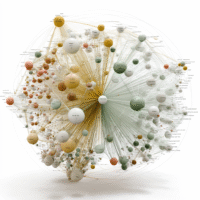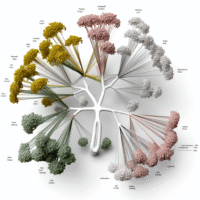AI Tech News
-
NVIDIA ViPE: Revolutionizing 3D Video Annotation for AI Researchers and Developers
Introduction to ViPE NVIDIA has recently launched ViPE, short for Video Pose Engine, which is a groundbreaking tool designed to enhance how we understand and utilize 3D data from standard 2D video footage. This innovation addresses the prevalent challenges faced in the realm of Spatial AI, specifically the difficulty of extracting 3D information from everyday […] ➡️➡️➡️
-
Meta AI’s MobileLLM-R1: Lightweight Edge Reasoning Model with 2x–5x Performance Boost
Introduction to MobileLLM-R1 Meta has recently introduced MobileLLM-R1, a series of lightweight edge reasoning models designed to enhance efficiency in mathematical, coding, and scientific reasoning. With parameters ranging from 140 million to 950 million, these models are now available on Hugging Face, making them accessible for various applications. Understanding the Target Audience The launch of […] ➡️➡️➡️
-
Building Explainable AI for Legal Professionals: Bridging the Gap Between Technology and Law
Understanding the Target Audience for Beyond the Black Box The primary audience for “Beyond the Black Box: Architecting Explainable AI for the Structured Logic of Law” includes legal professionals, AI developers, and regulatory bodies. These groups are keenly interested in how artificial intelligence can be integrated into legal frameworks while adhering to existing regulations. Their […] ➡️➡️➡️
-
Build Interactive Experiment Dashboards with Hugging Face Trackio: A Coding Guide for Data Scientists
Understanding the Target Audience The primary audience for this guide includes data scientists, machine learning engineers, and business analysts who are keen on improving their experiment tracking skills. These professionals often face challenges such as managing multiple experiments, lacking real-time insights into models, and struggling to visualize results effectively. Their goal is to streamline workflows […] ➡️➡️➡️
-
Top 5 No-Code Tools Revolutionizing AI Development for Engineers
In an era where artificial intelligence is rapidly evolving, no-code tools are revolutionizing the way AI applications are built and deployed. These platforms allow individuals without coding skills to create intelligent solutions, streamlining processes and enhancing productivity. Whether you are an entrepreneur, a marketer, or an engineer, understanding these tools can significantly boost your ability […] ➡️➡️➡️
-
Optimizing AI Performance: A Guide to GPU Frameworks like CUDA, ROCm, Triton, and TensorRT
Understanding GPU Optimization in AI Frameworks As the demand for advanced artificial intelligence (AI) grows, so does the need for efficient processing on Graphics Processing Units (GPUs). Developers, data scientists, and business managers in tech companies are particularly focused on optimizing deep learning workloads. The right software frameworks can significantly impact the performance of AI […] ➡️➡️➡️
-
AU-Harness: Revolutionizing Audio LLM Evaluation with an Open-Source Toolkit
The Rise of Voice AI and the Need for Better Evaluation Tools Voice AI is rapidly becoming a key player in the world of multimodal artificial intelligence. From virtual assistants like Siri and Alexa to interactive customer service agents, the ability of machines to understand and respond to audio is transforming human-computer interaction. However, as […] ➡️➡️➡️
-
Top 12 Essential Robotics AI Blogs and News Websites for 2025
Staying Ahead in Robotics and AI: The Essential Blogs and Websites As robotics and artificial intelligence (AI) rapidly advance, keeping up with the latest developments is crucial for professionals, enthusiasts, and students alike. The fusion of these technologies is reshaping industries, enhancing automation, and improving human-machine collaboration. To navigate this dynamic landscape, here are twelve […] ➡️➡️➡️
-
Build a Robust Advanced Neural AI Agent: Stability, Adaptability, and Intelligent Decision-Making for Data Professionals
Understanding the Advanced Neural Agent The Advanced Neural Agent (ANA) is a powerful tool designed to tackle the complexities of machine learning tasks. By combining classical neural network techniques with modern stability improvements, the ANA offers a robust solution for data scientists and machine learning engineers. This section will explore the key components that make […] ➡️➡️➡️
-
Google AI Unveils VaultGemma: Advanced 1B-Parameter Model with Differential Privacy for Safe AI Applications
The Importance of Differential Privacy in Large Language Models As artificial intelligence continues to evolve, the need for privacy in data handling has become paramount. Large language models (LLMs) like VaultGemma are trained on vast datasets, which can sometimes lead to the unintended exposure of sensitive information. Differential Privacy (DP) serves as a crucial safeguard, […] ➡️➡️➡️
-
IBM Unveils Efficient Granite Embedding Models for High-Performance AI Retrieval
Introduction to IBM’s New Embedding Models IBM is making waves in the AI community with the release of two new embedding models: granite-embedding-english-r2 and granite-embedding-small-english-r2. These models, built on the ModernBERT architecture, are tailored for organizations looking to enhance their search and retrieval systems. They combine compact design with efficiency, catering to various computational budgets […] ➡️➡️➡️
-
Build a Multilingual OCR AI Agent in Python Using EasyOCR and OpenCV
How to Build a Multilingual OCR AI Agent in Python with EasyOCR and OpenCV Creating an Optical Character Recognition (OCR) agent that can handle multiple languages is an exciting project, especially with tools like EasyOCR and OpenCV. This guide will walk you through the steps of building an advanced OCR AI agent using Python, all […] ➡️➡️➡️
-
Optimize LLM Inference with BentoML’s Open-Source llm-optimizer Tool
BentoML has launched an exciting new tool called llm-optimizer, an open-source framework aimed at optimizing the performance of self-hosted large language models (LLMs). This innovative tool tackles one of the significant challenges in the deployment of LLMs: determining the ideal settings for latency, throughput, and cost without the hassle of manual trial-and-error methods. Challenges in […] ➡️➡️➡️
-
Deepdub Lightning 2.5: Transforming Real-Time AI Voice for Enterprises and Scalable Applications
Introduction to Lightning 2.5 Deepdub, a pioneering voice AI startup from Israel, has recently unveiled its latest innovation, Lightning 2.5. This real-time foundational voice model is designed to enhance scalable voice applications, making it a game-changer for industries that rely on effective communication. With significant improvements in performance and efficiency, Lightning 2.5 is set to […] ➡️➡️➡️
-
TwinMind’s Ear-3: Revolutionizing Voice AI with Unmatched Accuracy and Multilingual Support
Understanding the Target Audience The launch of TwinMind’s Ear-3 model is particularly relevant for businesses and developers who are in search of advanced speech recognition solutions. The main audience encompasses: Enterprise users: Sectors such as legal, medical, and education require high accuracy in transcription to ensure effective communication. Developers: These individuals look for seamless integration […] ➡️➡️➡️
-
Top Open-Source OCR Models: A Comprehensive Guide for Developers and Researchers
Optical Character Recognition (OCR) is a transformative technology that converts images of text into machine-readable formats. This process is essential for digitizing documents like scanned pages, receipts, or photographs, making them accessible for various applications. Over the years, OCR has evolved significantly, moving from simple rule-based systems to sophisticated neural networks capable of interpreting complex […] ➡️➡️➡️
-
“Unlocking ChatGPT’s Potential: Full MCP Tool Support for Developers”
OpenAI has recently made a significant enhancement to ChatGPT by introducing full support for Model Context Protocol (MCP) tools in its developer mode. This upgrade transforms ChatGPT from a simple query assistant into a powerful orchestration layer capable of executing complex workflows and automating tasks. Understanding MCP Tool Support Previously, the capabilities of MCP integrations […] ➡️➡️➡️
-
Introducing mmBERT: The Next-Gen Multilingual Encoder Model for NLP Enthusiasts
Why was a new multilingual encoder needed? The field of multilingual natural language processing (NLP) has seen significant advancements over the past five years, with models like XLM-RoBERTa (XLM-R) leading the charge. However, as research has shifted towards decoder-based generative models, the development of efficient multilingual encoders stagnated. Despite their efficiency in tasks like embedding, […] ➡️➡️➡️
-
Build Advanced MCP Agents: Enhance AI Coordination and Context Awareness for Business Success
Building Advanced MCP Agents Creating advanced Model Context Protocol (MCP) agents can significantly enhance decision-making and operational efficiency in various fields. This guide provides a straightforward approach to developing MCP agents that leverage multi-agent coordination, context awareness, memory management, and dynamic tool usage. The focus is on practical applications, ensuring that the concepts can be […] ➡️➡️➡️
-
NVIDIA’s Universal Deep Research: Revolutionizing Scalable AI Workflows for Researchers and Enterprises
Understanding the Target Audience NVIDIA’s Universal Deep Research (UDR) is designed with a specific audience in mind. It caters to AI researchers, data scientists, business analysts, and enterprise decision-makers. These professionals often work in high-stakes environments, like finance and healthcare, where they face unique challenges: Inflexibility in existing deep research tools, which limits their ability […] ➡️➡️➡️


















